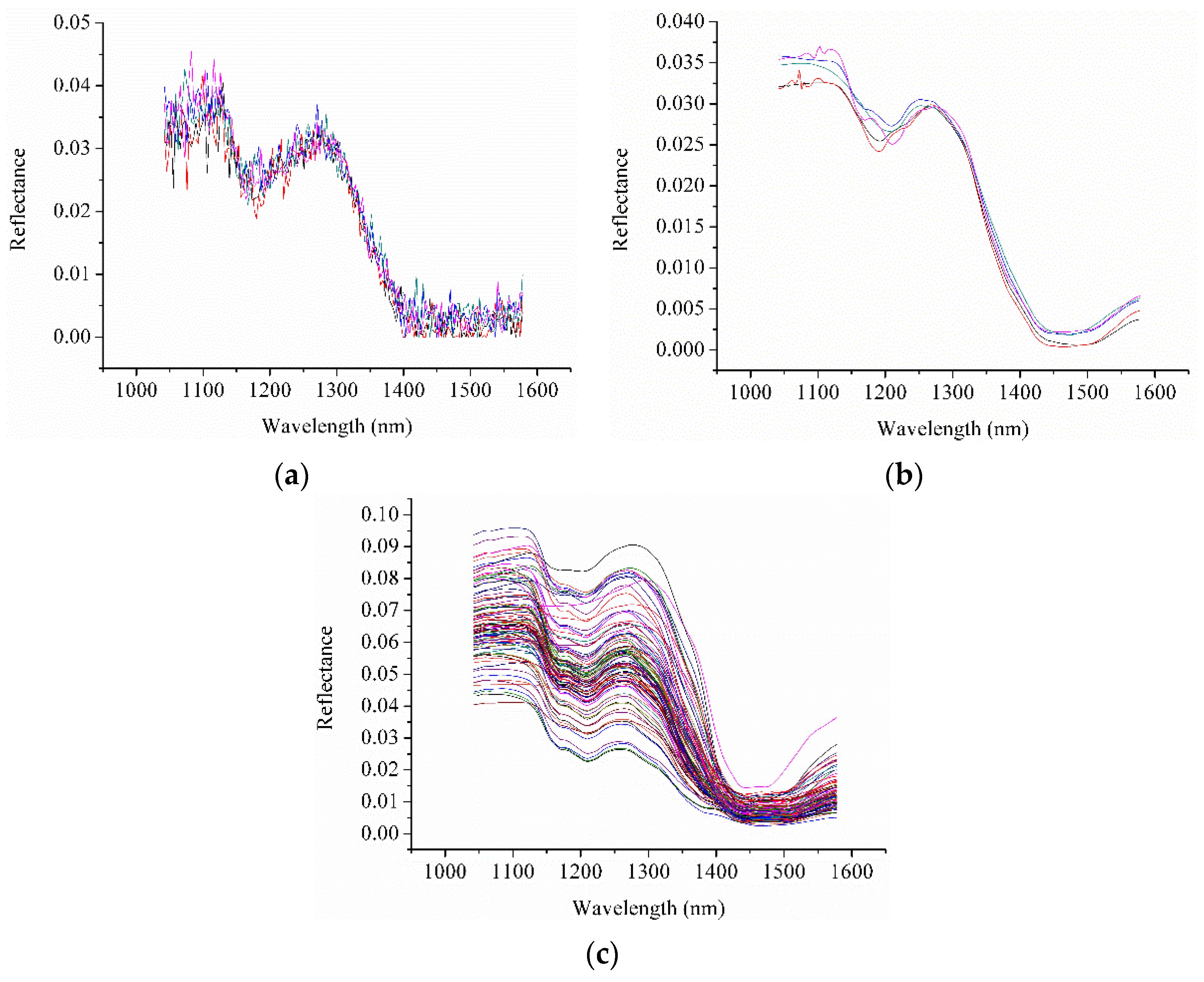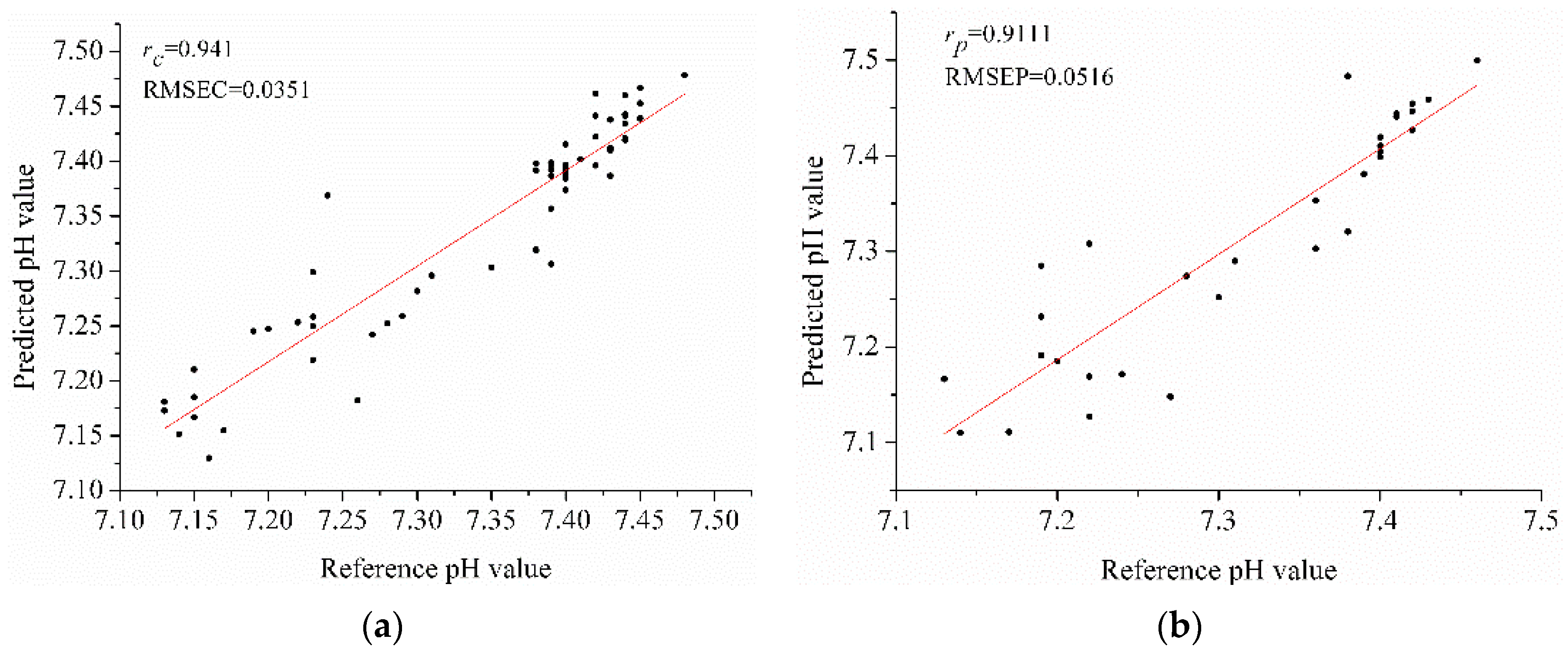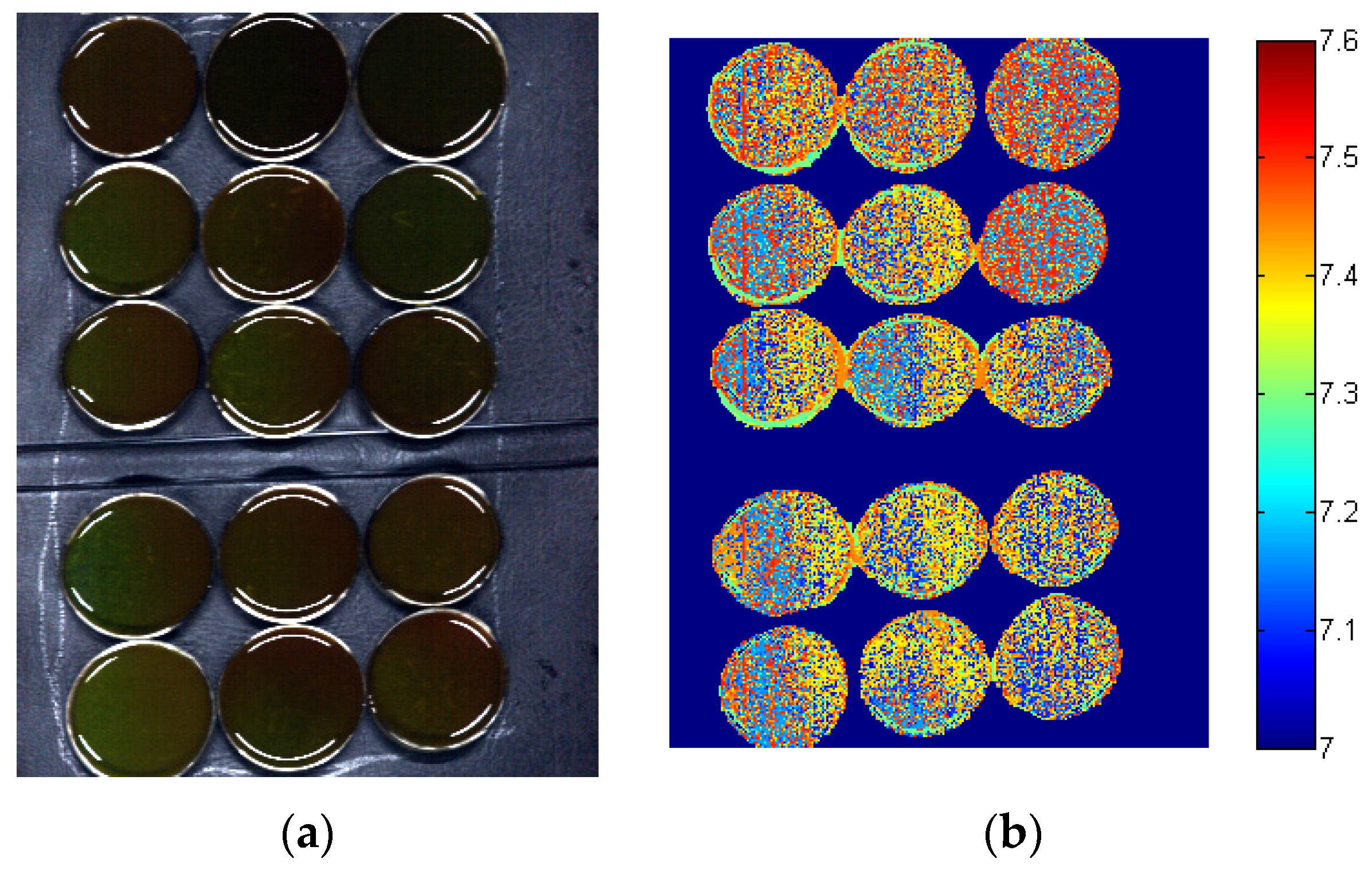Determination and Visualization of pH Values in Anaerobic Digestion of Water Hyacinth and Rice Straw Mixtures Using Hyperspectral Imaging with Wavelet Transform Denoising and Variable Selection
Abstract
:1. Introduction
2. Materials and Methods
2.1. Sample Preparation
2.2. Hyperspectral Imaging System and Image Acquisition
2.3. Hyperspectral Image Acquisition and Correction
2.4. Spectral Data Extraction
2.5. Measurement of pH Vvalue
2.6. Chemmometric Methods
2.6.1. Spectra Preprocessing
2.6.2. Calibration Methods
2.6.3. Optimal Wavelength Selection
2.7. Image Visualization of pH Distribution
- Extract the spectral data from the predefined ROI of the images segmented from the background.
- Build a calibration model using the average spectra of the samples.
- Select the optimal wavelengths and build the calibration model using optimal wavelengths. This procedure is optional.
- Apply the calibration model on each pixel within the image to form a distribution map.
2.8. Model Evaluation and Software
3. Results and Discussion
3.1. Spectral Features
3.2. Split of Sample Sets
3.3. Calibration Models on Full Spectra
3.4. Optimal Wavelength Selection
3.5. Calibration Models on Optimal Wavelengths
3.6. Image Visualization of pH Ddistribution
4. Conclusions
Acknowledgments
Author Contributions
Conflicts of Interest
References
- Godin, B.; Lamaudière, S.; Agneessens, R.; Schmit, T.; Goffart, J.-P.; Stilmant, D.; Gerin, P.A.; Delcarte, J.A. Chemical Composition and Biofuel Potentials of a Wide Diversity of Plant Biomasses. Energy Fuels 2013, 27, 2588–2598. [Google Scholar] [CrossRef]
- Bessou, C.; Ferchaud, F.; Gabrielle, B.; Mary, B. Biofuels, greenhouse gases and climate change. A review. Agron. Sustain. Dev. 2011, 31, 1–79. [Google Scholar] [CrossRef] [Green Version]
- Godin, B.; Lamaudière, S.; Agneessens, R.; Schmit, T.; Goffart, J.-P.; Stilmant, D.; Gerin, P.A.; Delcarte, J.B. Chemical characteristics and biofuel potential of several vegetal biomasses grown under a wide range of environmental conditions. Ind. Crops Prod. 2013, 48, 1–12. [Google Scholar] [CrossRef]
- Sasmal, S.; Goud, V.; Mohanty, K. Determination of salutary parameters to facilitate bio-energy production from three uncommon biomasses using thermogravimetric analysis. J. Therm. Anal. Calorim. 2013, 111, 1649–1655. [Google Scholar] [CrossRef]
- Dinuccio, E.; Balsari, P.; Gioelli, F.; Menardo, S. Evaluation of the biogas productivity potential of some Italian agro-industrial biomasses. Bioresour. Technol. 2010, 101, 3780–3783. [Google Scholar] [CrossRef] [PubMed]
- Lima, M.; Gomez, L.; Steele-King, C.; Simister, R.; Bernardinelli, O.; Carvalho, M.; Rezende, C.; Labate, C.; deAzevedo, E.; McQueen-Mason, S.; et al. Evaluating the composition and processing potential of novel sources of Brazilian biomass for sustainable biorenewables production. Biotechnol. Biofuels 2014, 7, 10–16. [Google Scholar] [CrossRef] [PubMed] [Green Version]
- Appels, L.; Lauwers, J.; Degrève, J.; Helsen, L.; Lievens, B.; Willems, K.; Van Impe, J.; Dewil, R. Anaerobic digestion in global bio-energy production: Potential and research challenges. Renew Sust. Energ. Rev. 2011, 15, 4295–4301. [Google Scholar] [CrossRef]
- Ward, A.J.; Hobbs, P.J.; Holliman, P.J.; Jones, D.L. Optimisation of the anaerobic digestion of agricultural resources. Bioresour. Technol. 2008, 99, 7928–7940. [Google Scholar] [CrossRef] [PubMed]
- Menardo, S.; Balsari, P. An Analysis of the Energy Potential of Anaerobic Digestion of Agricultural By-Products and Organic Waste. Bioenerg. Res. 2012, 5, 759–767. [Google Scholar] [CrossRef]
- Ward, A.J.; Lewis, D.M.; Green, F.B. Anaerobic digestion of algae biomass: A review. Algal Res. 2014, 5, 204–214. [Google Scholar] [CrossRef]
- Lindner, J.; Zielonka, S.; Oechsner, H.; Lemmer, A. Effect of different pH-values on process parameters in two-phase anaerobic digestion of high-solid substrates. Environ. Technol. 2015, 36, 198–207. [Google Scholar] [CrossRef] [PubMed]
- Campos, E.; Flotats, X. Dynamic simulation of pH in anaerobic processes. Appl. Biochem. Biotech. 2003, 109, 63–76. [Google Scholar] [CrossRef]
- Demirel, B.; Scherer, P. The roles of acetotrophic and hydrogenotrophic methanogens during anaerobic conversion of biomass to methane: A review. Rev. Environ. Sci. Biol. 2008, 7, 173–190. [Google Scholar] [CrossRef]
- Stockl, A.; Loeffler, D.; Oechsner, H.; Jungbluth, T.; Fischer, K.; Kranert, M. Near-infrared-reflection spectroscopy as measuring method to determine the state of the process for automatic control of anaerobic digestion. Inter. J. Agric. Biol. Eng. 2013, 6, 63–72. [Google Scholar]
- Krapf, L.C.; Nast, D.; Gronauer, A.; Schmidhalter, U.; Heuwinkel, H. Transfer of a near infrared spectroscopy laboratory application to an online process analyser for in situ monitoring of anaerobic digestion. Bioresour. Technol. 2013, 129, 39–50. [Google Scholar] [CrossRef] [PubMed]
- Kandel, T.P.; Gislum, R.; Jørgensen, U.; Lærke, P.E. Prediction of biogas yield and its kinetics in reed canary grass using near infrared reflectance spectroscopy and chemometrics. Bioresour. Technol. 2013, 146, 282–287. [Google Scholar] [CrossRef] [PubMed]
- Zhang, C.; Liu, F.; Kong, W.; He, Y. Application of Visible and Near-Infrared Hyperspectral Imaging to Determine Soluble Protein Content in Oilseed Rape Leaves. Sensors 2015, 15, 16576–16588. [Google Scholar] [CrossRef] [PubMed]
- ElMasry, G.; Sun, D.-W.; Allen, P. Near-infrared hyperspectral imaging for predicting colour, pH and tenderness of fresh beef. J. Food Eng. 2012, 110, 127–140. [Google Scholar] [CrossRef]
- Kamruzzaman, M.; ElMasry, G.; Sun, D.-W.; Allen, P. Prediction of some quality attributes of lamb meat using near-infrared hyperspectral imaging and multivariate analysis. Anal. Chim. Acta 2012, 714, 57–67. [Google Scholar] [CrossRef] [PubMed]
- Iqbal, A.; Sun, D.-W.; Allen, P. Prediction of moisture, color and pH in cooked, pre-sliced turkey hams by NIR hyperspectral imaging system. J. Food Eng. 2013, 117, 42–51. [Google Scholar] [CrossRef]
- Bonifazi, G.; Fabbri, A.; Serranti, S.A. Hyperspectral Imaging (HSI) approach for bio-digestate real time monitoring. In Proceedings of the Sensing for Agriculture and Food Quality and Safety, Baltimore, MD, USA, 5 May 2014; pp. 91080V-1–91080V-9.
- Shao, X.; Zhuang, Y. Determination of Chlorogenic Acid in Plant Samples by Using Near-Infrared Spectrum with Wavelet Transform Preprocessing. Anal. Sci. 2004, 20, 451–454. [Google Scholar] [CrossRef] [PubMed]
- Geladi, P.; Kowalski, B.R. Partial least-squares regression: A tutorial. Anal. Chim. Acta. 1986, 185, 1–17. [Google Scholar] [CrossRef]
- Wu, D.; Chen, J.; Lu, B.; Xiong, L.; He, Y.; Zhang, Y. Application of near infrared spectroscopy for the rapid determination of antioxidant activity of bamboo leaf extract. Food Chem. 2012, 135, 2147–2156. [Google Scholar] [CrossRef] [PubMed]
- Araújo, M.C.U.; Saldanha, T.C.B.; Galvão, R.K.H.; Yoneyama, T.; Chame, H.C.; Visani, V. The successive projections algorithm for variable selection in spectroscopic multicomponent analysis. Chemometr. Intell. Lab. 2001, 57, 65–73. [Google Scholar] [CrossRef]
- Gosselin, R.; Rodrigue, D.; Duchesne, C. A Bootstrap-VIP approach for selecting wavelength intervals in spectral imaging applications. Chemometr. Intell. Lab. 2010, 100, 12–21. [Google Scholar] [CrossRef]
- Li, H.-D.; Xu, Q.-S.; Liang, Y.-Z. Random frog: An efficient reversible jump Markov Chain Monte Carlo-like approach for variable selection with applications to gene selection and disease classification. Anal. Chim. Acta 2012, 740, 20–26. [Google Scholar] [CrossRef] [PubMed]
- Wu, D.; Wang, S.; Wang, N.; Nie, P.; He, Y.; Sun, D.-W.; Yao, J. Application of time series hyperspectral imaging (TS-HSI) for determining water distribution within beef and spectral kinetic analysis during dehydration. Food Bioprocess Technol. 2013, 6, 2943–2958. [Google Scholar] [CrossRef]
- Wu, D.; Shi, H.; Wang, S.; He, Y.; Bao, Y.; Liu, K. Rapid prediction of moisture content of dehydrated prawns using online hyperspectral imaging system. Anal. Chim. Acta 2012, 726, 57–66. [Google Scholar] [CrossRef] [PubMed]



| Sample Set | Number | Range | Mean | STD a |
|---|---|---|---|---|
| Calibration set | 62 | 7.13–7.48 | 7.34 | 0.10 |
| Prediction set | 31 | 7.13–7.46 | 7.31 | 0.10 |
| Models | LVs a/Nodes | Calibration | Prediction | ||
|---|---|---|---|---|---|
| rc | RMSEC | rp | RMSEP | ||
| PLS | 10/ | 0.904 | 0.0443 | 0.880 | 0.0695 |
| BP | /14 | 0.910 | 0.0446 | 0.894 | 0.0684 |
| Methods | Number | Optimal Wavelengths (nm) |
|---|---|---|
| SPA | 8 | 1210.29, 1395.67, 1129.54, 1287.75, 1058.95, 1574.74, 1520.64, 1372.05 |
| RF | 15 | 1378.8, 1274.27, 1183.36, 1237.22, 1240.59, 1270.91, 1301.23, 1375.42, 1277.64, 1129.54, 1176.63, 1109.36, 1159.8108, 1095.92, 1388.92 |
| VIP | 20 | 1042.16, 1045.52, 1156.4399, 1159.8108, 1163.9, 1166.54, 1203.55, 1206.92, 1210.29, 1213.65, 1217.02, 1355.1801, 1358.55, 1361.9301, 1365.3, 1395.67, 1399.04, 1402.42, 1405.79, 1409.17 |
| Methods | PLS | BP | ||||||||
|---|---|---|---|---|---|---|---|---|---|---|
| LVs | Calibration | Prediction | Nodes | Calibration | Prediction | |||||
| rc | RMSEC | rp | RMSEP | rc | RMSEC | rp | RMSEP | |||
| SPA | 7 | 0.891 | 0.0471 | 0.853 | 0.0697 | 6 | 0.941 | 0.0351 | 0.911 | 0.0516 |
| RF | 11 | 0.852 | 0.0545 | 0.829 | 0.0698 | 10 | 0.903 | 0.0463 | 0.877 | 0.0589 |
| VIP | 12 | 0.866 | 0.0519 | 0.822 | 0.0745 | 5 | 0.921 | 0.0417 | 0.820 | 0.0636 |
© 2016 by the authors; licensee MDPI, Basel, Switzerland. This article is an open access article distributed under the terms and conditions of the Creative Commons by Attribution (CC-BY) license (http://creativecommons.org/licenses/by/4.0/).
Share and Cite
Zhang, C.; Ye, H.; Liu, F.; He, Y.; Kong, W.; Sheng, K. Determination and Visualization of pH Values in Anaerobic Digestion of Water Hyacinth and Rice Straw Mixtures Using Hyperspectral Imaging with Wavelet Transform Denoising and Variable Selection. Sensors 2016, 16, 244. https://doi.org/10.3390/s16020244
Zhang C, Ye H, Liu F, He Y, Kong W, Sheng K. Determination and Visualization of pH Values in Anaerobic Digestion of Water Hyacinth and Rice Straw Mixtures Using Hyperspectral Imaging with Wavelet Transform Denoising and Variable Selection. Sensors. 2016; 16(2):244. https://doi.org/10.3390/s16020244
Chicago/Turabian StyleZhang, Chu, Hui Ye, Fei Liu, Yong He, Wenwen Kong, and Kuichuan Sheng. 2016. "Determination and Visualization of pH Values in Anaerobic Digestion of Water Hyacinth and Rice Straw Mixtures Using Hyperspectral Imaging with Wavelet Transform Denoising and Variable Selection" Sensors 16, no. 2: 244. https://doi.org/10.3390/s16020244







